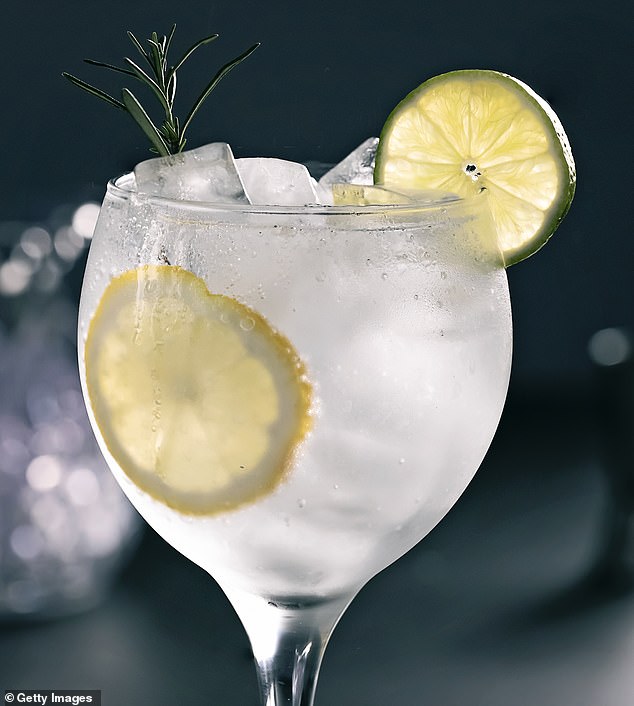It’s a classic cocktail with a seemingly simple recipe, but an expert has warned that most people are making gin and tonics all wrong.
While many pour a measure of gin over ice before adding tonic water and a slice of lemon, Sarah McDonald, brand manager at Caorunn Gin, a handcrafted premium gin from Scotland, has claimed otherwise.
Contrary to popular belief, McDonald revealed that gin should be served with a slice of apple as opposed to lemon or any other fruit slice.
She told The Daily Mail, ‘Caorunn gin recommends adding a slice of red apple to really elevate the crisp and unique, refreshing gin flavour with its juicy taste. Pink Lady apples are much more easily accessible and work well too.’
And while gin goblets are a popular choice to sip the beverage from in pubs across the UK, it’s a tall glass that should be used for the cocktail, she added.
‘For the perfect serve, Scottish gin brand Caorunn recommends 45ml Caorunn gin in a tall glass with plenty of ice, topped up with good quality tonic and a slice of red apple to really bring out the flavour of the gin.’
She added that keeping the gin bottle in the freezer is also key, as it helps create a ‘wonderfully velvety texture when pouring’.
To maintain a cool temperature while sipping on the drink, McDonald said medium-sized ice cubes are the best bet. ‘Make sure to use medium-sized cubes if possible and avoid shaved or crushed ice as this will melt and dilute your drink too quickly.’

It’s one of the most popular cocktails in the country – but an expert has warned that most people make gin and tonics all wrong (stock image)
While it might be tempting to sip on the drink after mixing the gin and tonic, the brand manager warned that the garnish is one of the most important parts.
She added, ‘Don’t skip the garnish! Put in that little extra time to perfect that gin and tonic experience and refill your ice cube trays to ensure you have lots of ice at hand.
‘Choose a premium tonic brand and use a jigger to perfect your pour, allowing you to measure accurately, one part gin, to two to three parts tonic. You may also choose to chill your glass in the freezer for an extra crisp gin and tonic.’
It comes after an expert weighed in on the debate of how to make the perfect cup of tea.
For most Britons, the ‘art’ of tea-making involves throwing a bag in a cup, pouring boiling water over it and then squeezing it with a teaspoon to within an inch of its life.
So perhaps it’s no wonder that according to some of the nation’s top connoisseurs, the road to a quintessential brew is one missed by many drinkers.
Thankfully, an expert has now set the record straight on how to make the perfect cuppa.
The hallowed cup of tea is a national institution in Britain, with 72 per cent of us drinking an average of four cups a day, a recent study commissioned by Aldi revealed.
But what it takes to make the perfect brew is certainly one of the most divisive debates Britons have among one another.
Should you put your milk in first or boiling water, and how long do you need to let the tea bag sit for? All these arguments about what consists of a good cuppa are constantly reignited in homes, staff rooms, with friends and even on TikTok, as most drinkers insist it’s their way or the highway.
Stephen Twining told the Daily Mail that a perfect cup of tea must contain two ‘key ingredients’, explaining: ‘One is the tea and the quality of that, the other is the water – that water is going to be the major part.’
The director of corporate relations and 10th generation member of the Twining family shared his personal method, which he revealed includes a ‘magic ingredient’.
‘How I do it is I empty my kettle of previously boiled water and put in fresh cold water from the tap – tap water in this country is great,’ he explained. ‘The fresh cold water contains the magic ingredient – dissolved oxygen.’
Dissolved oxygen (DO) is the amount of molecular oxygen, or O₂, gas present in a body of water.
The expert – who admits to drinking 10-15 cups of tea a day – explained that a higher amount of dissolved oxygen is needed to extract the tea’s flavour. However previously boiled water, or that emitted from a tap, contains less dissolved oxygen, resulting in a weaker taste.
‘You can brew it [your tea] in a cup or a mug,’ continued Stephen, before proceeding to debunk the myth that loose leaf tea tastes better than tea bags. He said what mattered more was ‘where the tea bag is from’.
‘Tea is like wine’ added Stephen. ‘It is affected by the altitude and weather conditions [of the area where it is grown]’.
He also instructed tea lovers to add milk last to the beverage and to let the bag brew for at least three minutes.
Lastly, he warned ‘not to beat the tea bag with a teaspoon’.
‘The poor tea bag gets beaten and then the colour comes rushing out and you think “oh that’s looking good, that’s what my tea should look like”‘. But Stephen explained that this was not the case.
To remedy this he suggested opting for a teapot. That way the tea bag is left to steep in the water peacefully while it’s flavour is extracted ‘naturally’.
This article was originally published by a www.dailymail.co.uk . Read the Original article here. .

